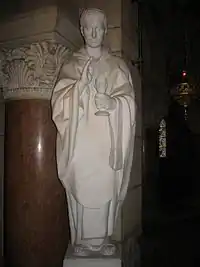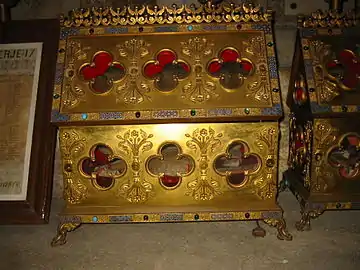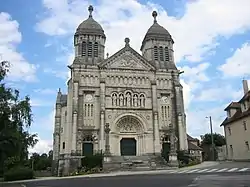Ferreolus and Ferrutio
Saints Ferreolus and Ferrutio (French: Ferréol et Ferjeux; Italian: Ferreolo e Ferruccio) (died ca. AD 212) are venerated as martyrs and saints by the Catholic Church, especially in Besancon where they are honored as its patron saints.
Saint Ferreolus and Ferrutio | |
|---|---|
 Statue of Ferreolus of Besançon. Basilique Saint-Ferjeux, near Besançon. | |
| Died | ~AD 212 |
| Venerated in | Roman Catholic Church, Eastern Orthodox Church |
| Major shrine | Basilica of Saint-Ferjeux |
| Feast | June 16 |
| Patronage | Besançon |
History
Their legendary acts state that they were brothers converted to Christianity by Saint Polycarp.[1] They were ordained as priest and deacon, respectively, by Saint Irenaeus of Lyons. They were sent to the area around Besançon as missionaries. They are called natives of Asia Minor;[2] Alban Butler held it "more probable that they were natives of Gaul who had studied in Asia Minor and come under Christian influence."[1] After working as missionaries amongst the Sequani for 30 years, in AD 212 during the persecution of Alexander Severus, they were arrested, tortured and beheaded.[3]
While aspects of their legend may not be entirely historical, it was likely based on someone named Ferreolus who assisted Irenaeus in spreading Christianity beyond Lyon.[4]
Veneration

According to their legend, their relics were discovered in a cave near Besançon in AD 370 by a military tribune whose dog was chasing a fox. The relics were enshrined by Bishop Anianus of Besançon in the 4th century AD.[1] Saint Gregory of Tours writes that miracles were attributed to their relics in his time; he says that his brother-in-law was cured of a dangerous distemper at the saints' intercession.[2] The Missale Gothicum (ca. AD 700) contains a full proper of the Mass in their honor.[1] In the sixteenth century, they were invoked in Besançon against sickness, along with Saint Sebastian and Saint Roch.[5]
Ferreolus appears in a catalogue of the 17th century as a bishop of Besançon, but the liturgy of Besançon has always remembered Ferreolus as a priest, and Ferrutio as a deacon.[6] Ferreolus and Ferrutio, as patrons of Besançon, are considered to have appeared on the city walls in times of danger.[6] The two saints have been represented in stained glass, paintings, and statues in many churches and chapels in the two dioceses of the Franche-Comté: Saint-Claude and Besançon.[6]
The Basilique Saint-Ferjeux is situated in the neighborhood of Saint-Ferjeux, Besançon.
They are depicted on a French lantern slide dating from AD 1900.
Gallery
 Reliquary of Saint Ferrutio. Crypt of the Basilica Saint Ferjeux de Besançon.
Reliquary of Saint Ferrutio. Crypt of the Basilica Saint Ferjeux de Besançon. Basilique Saint-Ferjeux
Basilique Saint-Ferjeux
Notes
- Alban Butler; Paul Burns, Butler's Lives of the Saints (Continuum International, 2000), 117.
- Rabenstein, Katherine (June 1998). "Ferreolus and Ferrutio MM (RM)". Saints O' the Day for June 16. Archived from the original on 2007-11-05. Retrieved 2007-12-10.
- "Latin Saints of the Orthodox Patriarchate of Rome", Orthodox Europe
- Holmes, T. Scott. The Origin and Development of the Christian Church in Gaul During the First Six Centuries of the Christian Era, Mac Millan, 1911, p. 54
- "L'origine des maladies" (in French). Retrieved 2007-12-10.
- Borrelli, Antonio (2003-02-06). "Santi Ferreolo e Ferruccio". Santi Beati (in Italian). Retrieved 2007-12-10.
External links
- Saint Ferréol et Saint Fargeau (in French)
- Diocèse de Besançon (in French)
- Santi Ferreolo e Ferruccio from Santi Beati (in Italian)